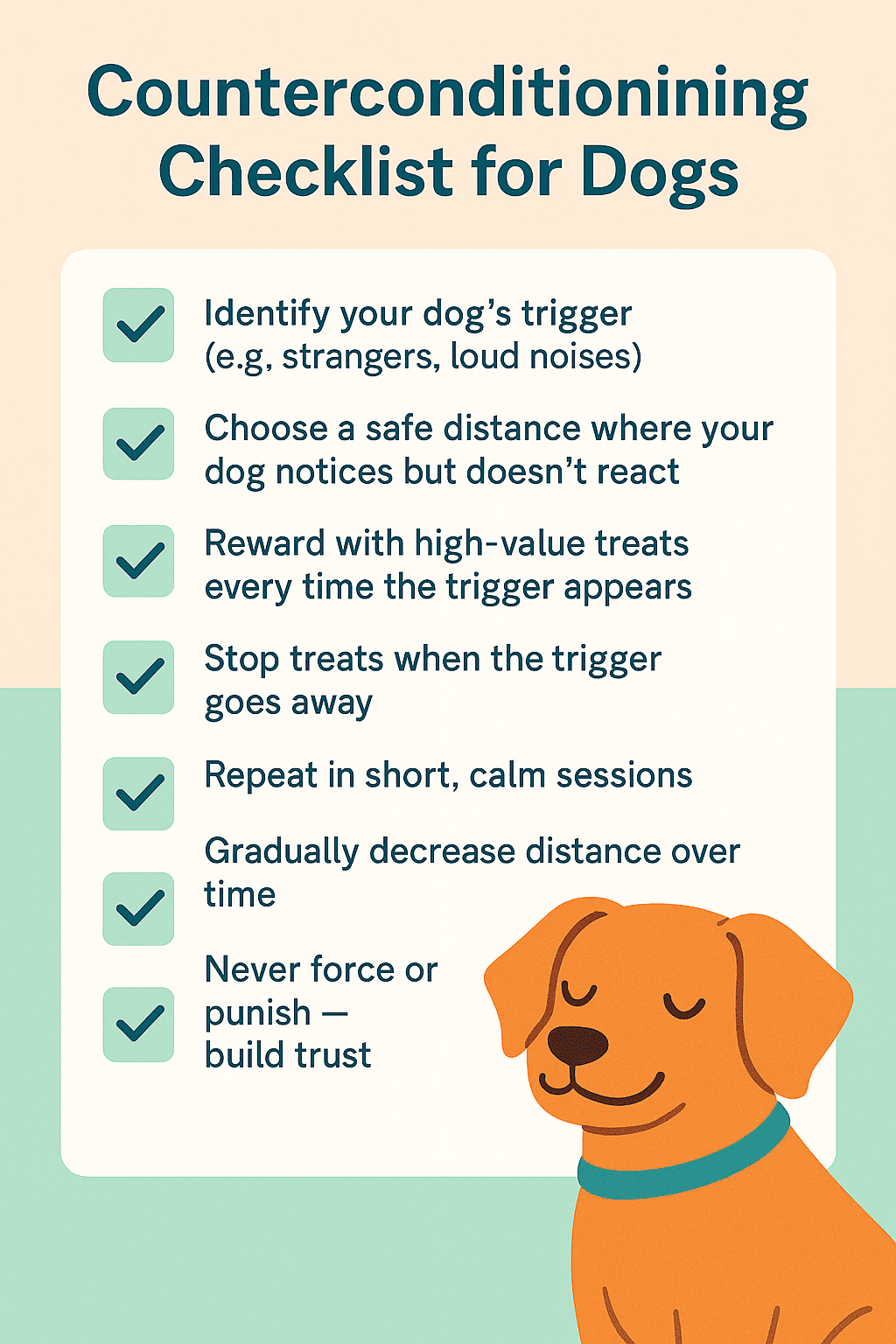
❓Does This Sound Like Your Dog?
Is your dog terrified of the mailman—or anyone wearing a uniform?
Does your dog completely lose it when the doorbell rings?
Is your dog afraid of the leash, harness, or even going outside?
Does your rescue panic when left alone, even for a few minutes?
Is your dog scared of loud noises like vacuums, fireworks, or thunder?
Does your dog refuse to enter certain rooms or cower in corners?
Is your dog terrified of their crate, even though you’ve tried everything?
Do vet visits feel like emotional trauma for both of you?
Counterconditioning is the absolute best method for everything here.
What Is Counterconditioning Dog Training?
Counterconditioning is a powerful behavior modification technique that changes your dog’s emotional response to something they fear or react to—turning anxiety into calm, and fear into trust. It’s not about obedience. It’s about emotional healing.
If your dog lunges at strangers, cowers during thunderstorms, or barks at the vacuum, they’re not being stubborn—they’re overwhelmed. Counterconditioning rewires how they feel about those triggers using gentle, science-based steps.
🚫 The Wrong Assumption: “My Dog Just Needs to Stop”
Punishing fear-based behaviors or forcing your dog into scary situations doesn’t work. It often backfires, making the problem worse. Counterconditioning addresses the root cause—your dog’s emotional state—so behavior changes naturally and permanently.
🔄 Why Counterconditioning Dog Training Works So Well
Counterconditioning dog training is a powerful, science-backed technique that helps dogs feel safe in situations that once triggered fear or anxiety. Instead of punishing reactions, it changes your dog’s emotional association with a trigger.
Here’s how it works—and why it matters:
- 🧠 It reshapes emotional responses.
Counterconditioning dog training helps your dog form new, positive feelings toward things they used to fear—like loud noises, unfamiliar people, or being left alone. - 🐾 It treats the root cause, not just the behavior.
Barking, lunging, or trembling often signals fear—not defiance. Counterconditioning builds confidence from the inside out. - 🍗 Triggers become signals for rewards.
A scary event is paired with something amazing (like steak), teaching your dog, “This is safe.” - 🔁 Consistency rewires the brain.
The more your dog has these safe, positive experiences, the faster fear is replaced with calm. - 🧩 It’s flexible and kind.
Counterconditioning dog training works with any breed, age, or background—and helps build stronger trust between you and your dog.
By meeting fear with compassion and patience, counterconditioning becomes one of the most humane and effective dog training tools available.
Want to dive deeper into the science of counterconditioning dog training?
Read the American Veterinary Society of Animal Behavior’s guide to humane dog training.
Explore how counterconditioning and reward-based methods are supported by decades of behavioral research.
✅ How Counterconditioning Works (Simple Breakdown)
- Find the Trigger: What scares or overstimulates your dog? (e.g., delivery trucks, children, fireworks)
- Create a Positive Association: Every time your dog sees or hears the trigger at a safe distance, they get high-value treats or play.
- Stay Below Threshold: Don’t push your dog too far. Success comes from slow, safe exposure.
- Repeat Consistently: With enough safe, positive experiences, fear fades—and is replaced by excitement or calm.
🎯 Real-World Example: Barking at Strangers
Instead of yelling or correcting, a counterconditioning protocol might look like this:
- Step 1: A stranger appears 50 feet away. You feed your dog steak.
- Step 2: Stranger walks away. Steak stops.
- Step 3: Repeat until your dog sees a stranger and turns to you happily.
Fear is replaced with anticipation of rewards. That’s counterconditioning.
📊 Why Counterconditioning Dog Training is Scientifically Proven to Work
Veterinary behaviorists and top trainers worldwide use counterconditioning dog training as the gold standard for reactivity, aggression, and fear-based issues. It’s foundational in treatment plans for separation anxiety, leash reactivity, and more.
Backed by:
- AVSAB (American Veterinary Society of Animal Behavior)
- Journal of Veterinary Behavior
- Renowned trainers like Karen Pryor, Dr. Sophia Yin, and Patricia McConnell
🧠 When to Use Counterconditioning
Use this method when your dog:
- Barks, growls, or hides in response to a person, object, or sound
- Freezes or panics in specific environments (e.g., vet office, car rides)
- Has a known trauma history or rescue background
💡 Pro Tip
Always pair counterconditioning with desensitization for best results. Desensitization controls the intensity of the trigger, while counterconditioning shifts your dog’s internal response.
🚀 Take the First Step
Start small. Pick one mild trigger your dog dislikes and turn it into a treat dispenser moment. One calm response at a time, you’re not just training—you’re rebuilding trust.
📍 Want more step-by-step examples? Stay tuned for our full Counterconditioning Protocol PDF guide—coming soon.

📚 Want to Master All 5 Training Principles?
Each method builds on the others. Explore them all to truly understand how dogs learn — and how to train with clarity, confidence, and compassion.
🎁 Ready to test your skills?
Get the Free Quiz Pack
